Pioneering Women in Science
Air Date: Week of January 6, 2017
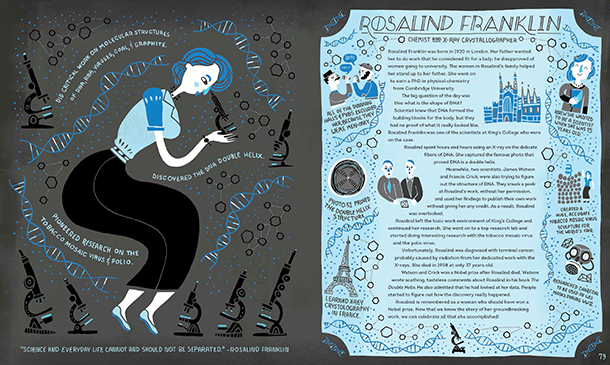
Rosalind Franklin’s work on x-ray diffraction helped lead to the discovery of the double-helix structure of DNA. (Photo: Reprinted with permission, Women in Science Copyright © 2016 by Rachel Ignotofsky. Published by Ten Speed Press, an imprint of Penguin Random House LLC.)
Women have historically been underrepresented in science and engineering, but that didn’t stop Marie Curie, Jane Goodall, and Rachel Carson, and there are many more women in these fields who are not as famous. Artist and author Rachel Ignotofsky joins host Steve Curwood to share the contributions of some of the remarkable female scientists she profiles in her new book, Women in Science: 50 Fearless Pioneers Who Changed the World.
Transcript
CURWOOD: It’s Living on Earth, I’m Steve Curwood. Women and girls make up half of humanity, yet they have been historically under-represented in many endeavors, including science and technology. But prejudice and the accusation of unladylike behavior didn’t stop the likes of Marie Curie, Jane Goodall, Rachel Carson, and many others, famous and not so famous. Rachel Ignotofsky has gathered some worth celebrating in the book, “Women in Science: 50 Fearless Pioneers Who Changed the World”. She joins us today to share the contributions of some of these remarkable women. Welcome to Living on Earth, Rachel.
IGNOTOFSKY: Hi, how are you doing?
CURWOOD: So, what inspired you to write this work?
IGNOTOFSKY: Well, for me, I have a lot of friends in education, and we were talking a lot about the gender gap in the STEM fields. Why is math and science still considered such a boys’ game? And I just kept saying over and over again, we maybe only talk about female scientists during women's history month. We're not taught about them in school. We're not taught about them in history class, and the only one that we do talk about is Marie Curie. So, what happens to young girls and boys when you're not introduced to these strong female role models, who all throughout history have made an immense impact on the sciences? I just kept talking about it and talking about it, and after a while, if you say something enough and you don't do something, you're just a schmuck.
[CURWOOD LAUGHS]
IGNOTOFSKY: So, yeah, I started using my own skill set to try and be a part of the conversation a positive way. So I started making these posters that really celebrated some women in science that I thought were great and really talk about their accomplishments and hopefully get more people interested in talking about them.
CURWOOD: I have to say the illustrations in your book are, well, they're really pretty amazing. I mean, yes, you've written up all these women who did something in science or technology or engineering or mathematics, and you've drawn these exquisite pictures of them with all these images around them.
IGNOTOFSKY: Yeah, well, I really think that illustration is really one of the most powerful tools to get people excited about learning. When something is beautiful, when you take the time to take dense information and make it digestible and fun and whimsical, all of a sudden you get to engage with a whole new audience.
CURWOOD: I have to say your illustrations on all these women include lipstick.
IGNOTOFSKY: [LAUGHS] Well, I wanted to make all of the images really bright and really vibrant, so each page is kind of this monochromatic image. All the women are either bright green or bright purple on this dark charcoal background. It kind of makes them kind of just pop off the page and kind of gives you this sort of excitement and wonder that they're kind of feeling while making their discoveries. The field that they contributed to, whether it's vulcanology or marine biology or chemistry, I put those objects around them, kind of floating around them, and you can kind of just feel this wonderment of discovery and exploration.
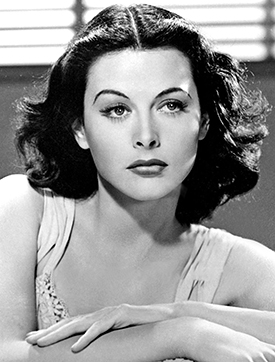
Although she was known primarily as an actress in the Golden Age of Hollywood, Hedy Lamarr was also a revolutionary scientist. She invented technology for torpedoes that is still used in Wifi today. (Photo: MGM / Clarence Bull, Wikimedia Commons Public Domain)
CURWOOD: So, these women have incredible stories. Why haven't we heard most of them?
IGNOTOFSKY: I think it's two things. I think, one, there's institutional sexism where we just don't have a lot of accessible materials about these woman. I don't think a lot of people are taking the time to tell their stories when they're not a part of our culture to begin with, when people don't already know who they are. So, it's kind of this vicious cycle.
CURWOOD: Well, there's some women in your book that we know much about, but we don't know about this part of them. I'm thinking of Hedy Lamarr. I mean, tell us that story.
IGNOTOFSKY: Hedy Lamarr was born Hedwig Eva Maria Kiesler in 1914, Vienna, Austria. See, she's really known for being a movie star. She was called the most beautiful woman in the world, but what a lot of people don't know is that, in fact, she had this need to invent. She had a secret laboratory in her room where she would experiment. Actually she was married at one point to an arms dealer, back where she lived in Germany, and she escaped him and came to America. But when she was there she learned a lot about technology and torpedoes, and when she was in America and World War II started she started, she wanted to do what she could to help. She knew that torpedo signals often got jammed. So, together with the composer George Antheil, she created FHSS technology, which was a frequency that actually would change and switch much like a player piano. That's kind of where they got the idea for it.
George Antheil at the time was working a lot with player pianos and they created this technology and it worked really well. Torpedoes wouldn't get jammed, and they patented it, and they presented it to the US government, but they did not take her seriously, and they shelved her idea. And she helped the war movement the way that they would allow her to, which was in a kissing booth raising money for war bonds.
Later, much later, during the Cuban Missile Crisis, they realized what a wealth of technology this was, and they started applying her patent, which was expired at the time, to missiles. And now we use it in Wi-Fi and our cell phones and Bluetooth every single day. So, it's one of those bittersweet stories where, yes, she got the recognition that she deserved at the end, and, yes, now her technology is readily available and used by everyone. But just think about all that wasted time in between World War II and the Cuban Missile Crisis where she could have been developing even more technology and been taken seriously.
CURWOOD: Hedy Lemar, you know she was back in the Golden Age of Hollywood. Talk to me about Mamie Phipps Clark.
IGNOTOFSKY: Mimi Phipps Clark was born in 1917 in Arkansas. She is a social scientist, and she's a psychologist, and she's best known for her participation in the Civil Rights Movement with the color doll test that she developed with her husband Kenneth Clark. That's the test that was used as the basis of the argument to win the court case during Brown versus Board of Education and end segregation.
But her work actually started much earlier than that. She always wanted to work with kids, and when she was getting her Masters she decided to focus on preschoolers. She wanted to know if preschoolers identified with their race. At the time people thought that kids that young didn't understand that they belong to a race, but she proved through a picture test that kids as young as three or four understood that they were white or black, and this was her big “Aha!” moment. She realized that she could do this work in race and objectively prove that segregation was damaging children.

A two-page spread featuring Marie Curie from Ignotofsky’s book Women in Science. (Photo: Reprinted with permission, Women in Science copyright © 2016 by Rachel Ignotofsky. Published by Ten Speed Press, an imprint of Penguin Random House LLC.)
So, she wanted to know what happens to a child when they're separated. So, she did the doll test, and, for those of you who don't know, it was a test that was given to kids in segregated and desegregated schools. They had identical looking baby dolls. One was black, one was white, and they would ask questions. "Is this doll pretty? Is this doll good?" And, overwhelmingly, the black children in segregated schools would only choose the white dolls, and they would say that the black doll was ugly and bad. In turn, they thought they were ugly and bad because they were separated. I just really wanted to include her in this book to show that science can be used to change society, can be used for social good for the better.
CURWOOD: I have to say when I picked up your book I had never heard of Vera Rubin, and yet she’s instrumental in changing what we understand and know about the universe. Can you tell me her story, please?
IGNOTOFSKY: Yes. Vera Rubin was born in 1928 in Philadelphia, and she grew up in Washington DC. So, Vera Rubin gave us the ultimate proof that dark matter exists in this universe. That's huge. She was kind of looking at the movement of galaxies, and she was thinking that they would move the same way that solar systems did. When you're further away from the gravity point, and in the solar system the gravity point is the sun, you move slower. But, when she was looking at these galaxies, that was not the case. In fact, everything moved at the same speed and what was causing that?
It meant that there must be this invisible gravity source that was floating throughout the universe. And this invisible undetectable gravity source was dark matter. And this was affecting the way that the entire universe moved and it also, through her studies, she figured out that it made up most of our universe. And so scientists still don't know what that is, and there is still so much that we still need to learn about dark matter. But, by studying movement, she had the most undeniable proof that this was something that was real, that even though we can't see it, it's impacting our universe.
CURWOOD: Tell me about Jane Cooke Wright.
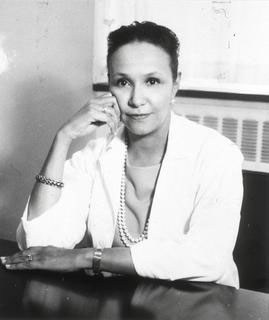
Jane Cooke Wright was a leader in oncology. (Photo: National Library of Medicine)
IGNOTOFSKY: Jane Cooke Wright was born in 1919 and grew up in New York. She was one of the leaders in oncology, and she grew up during a time where most women weren't doctors. There were few African-American doctors as well. So, she started working with her father, and her father was a very famous doctor, already in the field of oncology, and they started working together. And when he died she took over the department, and she became the youngest head of a department in cancer research, and she started looking at cancer in a new way.
At the time, people didn't really understand chemotherapy. You would take the chemotherapy and just nuke the whole body, but she thought there could be a different way. Instead, she started testing tumor samples outside the body, creating individual cocktails for patients that they would respond to the best, and she also developed a catheter system. So, instead of having to nuke the whole body she would just go in and treat just the organ that was being affected by the cancer.
She went on to be the founder of an oncology foundation, and she saved countless lives doing it.
CURWOOD: Rachel, what's the story of Sau Lan Wu?
IGNOTOFSKY: Sau Lan Wu was born in the early 1940s. We're not really sure of the date that she was born because it was during the Japanese occupation of Hong Kong, and her mom was illiterate. But her mom did everything she could to make sure that her and her brother got the best education that they possibly could. And she wasn't going to go to college unless she got a full ride, and the only place that gave it to her was Vassar University. They paid for everything, her food, her clothes, her books, her dorm room. And she came over on a boat with just a little pocket change and some cake. And she had three goals, to make three major discoveries in her life, and she did.
She had an interest in particle physics. She wanted to find out what all this stuff in the universe was made out of, and that meant what are the particles an atom is made out of. After discovering the charm quark, she went on to discover gluons, and gluons are kind of the stuff that holds all of the subatomic particles together.

Edith Clarke was the first professionally employed female electrical engineer in the United States. (Photo: Reprinted with permission, Women in Science Copyright © 2016 by Rachel Ignotofsky. Published by Ten Speed Press, an imprint of Penguin Random House LLC.)
After those two discoveries, she made a really big one. She led a research team that discovered the Higgs boson. And bosons kind of give mass to these subatomic particles, and they make the whole thing work. They make everything kind of just stick together and work, and they are the reason that, you know, we're not just falling apart and flying off into a million pieces. So, with the particle accelerator she got to work and she said it was going to be as hard as finding a needle in a haystack the size of a stadium, and, yes, she made her third discovery.
CURWOOD: You have a lot of other scientists in this book. Of course, there's Rachel Carson, there's Sylvia Earle, there's Barbara McClintock. Who were the notable scientists that there wasn't enough room to include?
IGNOTOFSKY: There were a lot. I mean, I could have filled this entire book with all chemists. It could have been Women in Chemistry, though the one that I really wish that I could have fit in is Janaki Ammal. And she was born in the late 1800s, grew up in the early 1900s in India. And at the time in India women weren't seen as part of the workforce. They were expected to be mothers. They were expected be wives, and that is it.
But Janaki Ammal, she was a botanist, and she developed sugarcane so that it could be grown in more places and more readily available to people. And she actually became one of the first women to work for the Indian government.
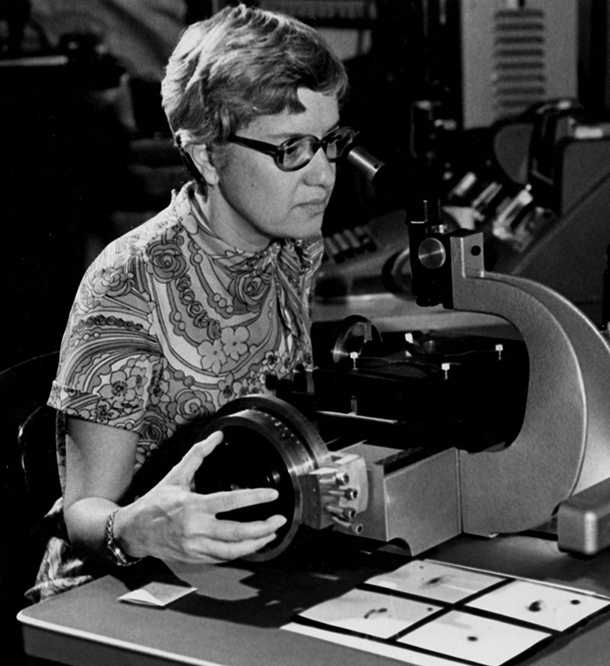
Vera Rubin discovered that most of our universe is made of dark matter (Photo: Emilio Segre Visual Archives, American Institute of Physics)
CURWOOD: Now, looking at your book, you report that there's still a 22 percent gender gap among science and engineering grads and a 52 percent gender gap among that whole workforce. Why is that?
IGNOTOFSKY: So, all that data is from the 2013 US Census, and I believe that the gap widens from the women graduating to women with jobs from a lack of opportunity, and I think, again, it's just institutionalized sexism. I think when people close their eyes and think of who a scientist is, they don't see a woman. And I think there's many ways that we need to fight this, I think, one, scholarships. Two, we need to get more women in positions of power in the STEM fields.
CURWOOD: How does the field deal with motherhood because if you're pursuing a doctorate, and you get to be age 26, 27, 28, you're really looking for that really key appointment to move forward and it's the same time in life of course that if women are going to choose to have children they need to get on with it. How sensitive to the realities of a female lifecycle is the STEM field, do you think?
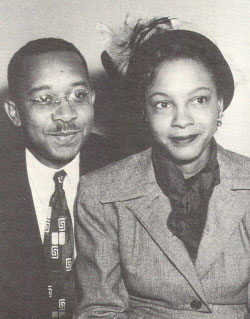
Mamie Phipps Clark, pictured here with her husband Kenneth Clark, was a social scientist that developed the doll test, a study that was used in Brown vs. Board of Education to prove that segregation was damaging. (Photo: Public Domain)
IGNOTOFSKY: I think it's gotten a lot better than it used to. For Sau Lan Wu, it was a decision for her to not have children so she could continue her work. And I know for a lot the female scientists they make that choice, but there are a lot of female scientists who have kids, and I think it really depends on their place of work. I think we all need to fight for better childcare, for having a time, a leave of absence that's respectable to the women who have just had birth.
And also, we just have to ask ourselves, you know, these men who have children, they're fathers. We don't ever ask them, “How come you're not home with the kids? Or how come you're not taking more time off to spend time with them?” I think there's a big double standard there, not only in STEM, but in all fields that we, as a society, have to be conscious of and have to fight.
CURWOOD: Well, how do you think the gender gap has changed over time?

Rachel Ignotofsky is an illustrator and author based in Kansas City, MO (Photo: Thomas Mason IV)
IGNOTOFSKY: I think it's gotten much better. I mean, when you look at what it used to be like in the 70s versus now, we've come a long way but there's still so much work to be done. Women only have 13 percent representation within engineering. That's not good. That's not sustainable. I hope that young girls see this. I want them to be able to see that, no matter what your gender is, you can pursue your passions, that there's no such thing as a girl’s job and a boy’s job. They're just jobs. And if you could do a good piece of work and are given the opportunity to do that work, you're going to succeed and you're going to go far.
CURWOOD: Rachel Ignotofsky's new book is called "Women in Science: 50 Fearless Pioneers Who Changed the World". It was written by Rachel and illustrated by her as well. Thank you so much, Rachel, for taking the time with us today.
IGNOTOFSKY: Thank you so much. It's been such a pleasure.
Links
Women in Science: 50 Fearless Pioneers Who Changed the World
New York Times: “Why Are There Still So Few Women in Science?”
Living on Earth wants to hear from you!
Living on Earth
62 Calef Highway, Suite 212
Lee, NH 03861
Telephone: 617-287-4121
E-mail: comments@loe.org
Newsletter [Click here]
Donate to Living on Earth!
Living on Earth is an independent media program and relies entirely on contributions from listeners and institutions supporting public service. Please donate now to preserve an independent environmental voice.
NewsletterLiving on Earth offers a weekly delivery of the show's rundown to your mailbox. Sign up for our newsletter today!
 Sailors For The Sea: Be the change you want to sea.
Sailors For The Sea: Be the change you want to sea.
 The Grantham Foundation for the Protection of the Environment: Committed to protecting and improving the health of the global environment.
The Grantham Foundation for the Protection of the Environment: Committed to protecting and improving the health of the global environment.
 Contribute to Living on Earth and receive, as our gift to you, an archival print of one of Mark Seth Lender's extraordinary wildlife photographs. Follow the link to see Mark's current collection of photographs.
Contribute to Living on Earth and receive, as our gift to you, an archival print of one of Mark Seth Lender's extraordinary wildlife photographs. Follow the link to see Mark's current collection of photographs.
 Buy a signed copy of Mark Seth Lender's book Smeagull the Seagull & support Living on Earth
Buy a signed copy of Mark Seth Lender's book Smeagull the Seagull & support Living on Earth

